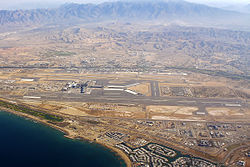Muscat International Airport
|
Muscat International Airport مطار مسقط الدولي |
|||||||||||||||
|---|---|---|---|---|---|---|---|---|---|---|---|---|---|---|---|
 |
|||||||||||||||
| Summary | |||||||||||||||
| Airport type | Military/Public | ||||||||||||||
| Operator | Oman Airports Management Company | ||||||||||||||
| Serves | Muscat | ||||||||||||||
| Location | Muscat, Oman | ||||||||||||||
| Hub for | |||||||||||||||
| Coordinates | 23°35′18.92″N 58°17′26.16″E / 23.5885889°N 58.2906000°ECoordinates: 23°35′18.92″N 58°17′26.16″E / 23.5885889°N 58.2906000°E | ||||||||||||||
| Map | |||||||||||||||
| Location of Airport in Oman | |||||||||||||||
| Runways | |||||||||||||||
|
|||||||||||||||
| Statistics (2015) | |||||||||||||||
|
|||||||||||||||
| Total passengers | 10,876,234 |
|---|---|
| Total Aircraft movements | 94,920 |
Muscat International Airport (IATA: MCT, ICAO: OOMS), formerly Seeb International Airport, is the main international airport in Oman. It is situated 32 km from the old city and capital Muscat within the Muscat metropolitan area. The airport serves as the hub for flag carrier Oman Air and features flights to several regional destinations as well as some intercontinental services to Asia, Africa and Europe.
The airport opened as Seeb International Airport in 1973, replacing a smaller airfield located in Bayt al Falaj.
It has hosted Royal Air Force BAe Nimrods in the past, including for the 1991 Gulf War. These aircraft cooperated with the Royal Navy of Oman in the 'Magic Roundabout' exercise series. The base was used by a detachment of Vickers VC10 tankers from No. 101 Squadron RAF during the Gulf War training with Royal Air Force SEPECAT Jaguars.
As of 1 February 2008, the airport's name has been changed from Seeb International Airport to Muscat International Airport.
The entire airport is spread over an area of 21 square kilometres (8.1 sq mi). It originally featured one passenger terminal building, one runway as well as minor cargo and maintenance facilities and is currently undergoing a major extension and replacement consisting of a second runway, an entirely new passenger terminal and a new control tower.
The airport currently features one single, two-storey passenger terminal. It has a T-shape and is equipped with 58 check-in counters, 23 departure gates, 3 baggage reclaim belts and some service counters and shops. The building, dating from the 1970s, has been expanded several times during the last years to cater for growing passenger numbers. However, it still has no aircraft stands equipped with jet-bridges, therefore bus-boarding is used for all operations. The existing terminal will be renamed to "Terminal 2" once the new terminal becomes fully operational and will handle low-cost flights.
...
Wikipedia

